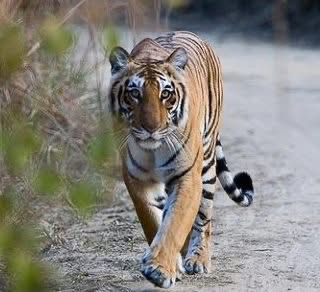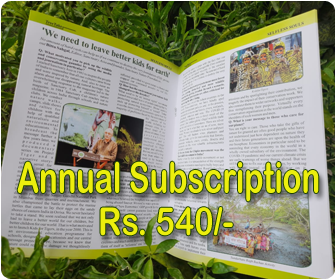Travelogue
HN Singh
My love affair with Corbett National Park began in March 1982, during a quieter time, when the air was less hurried, and the forests seemed untouched, as if held in a sacred pause. That first journey into the heart of the jungle wasn’t just a visit—it was a revelation, an awakening of something primal within me. Since then, the call of Corbett has echoed through my life, drawing me back time and again to its timeless wildness.
In 1982, I spent an unforgettable week at Dhikala, the park’s legendary rest house nestled along the edge of the Ramganga reservoir. The setting was a painter’s dream: vast grasslands brushed golden by the sun, the dense and towering Sal forests standing sentinel, and the shimmering river bending through the wilderness like a silver ribbon. Every day was a new chapter in a story only nature could write.
I explored every corner of the park—Bijrani, Jhirna, Dhela, Durga Devi, Garjia, Sitabani, and of course Dhikala. Each zone unveiled its own secrets: silent pathways, sudden rustles in the undergrowth, and trees alive with the flurry and flash of birds. It was during this trip that I experienced something truly extraordinary—an encounter that turned a memorable trip into a cherished life memory.
At Dhikala, fate brought me into the company of two towering figures of Indian heritage: Dr Salim Ali, the legendary "Birdman of India", and Naushad Sahab, the great music composer. Both were staying at Dhikala during my visit. To sit on the veranda in the fading light of dusk, listening to Dr Ali speak passionately about the flight patterns of birds, or to hear Naushad reminisce about music, melody, and his love for nature—it was like being in the presence of living poetry. Their words, like the forest itself, carried depth, wisdom, and wonder. We shared laughter, quiet musings, and stories under the open sky, as the sun sank behind the forest, painting the sky with hues only nature can conjure.
One of the most thrilling moments of that journey was a ride across the Ramganga reservoir in a jet boat gifted by Sir Edmund Hillary, the first man to conquer Mount Everest. The boat had once sailed from the Bay of Bengal to the Himalayas during Hillary’s legendary “Ocean to Sky” expedition, tracing the sacred Ganges from Kolkata to Gangotri. Sitting in that boat, cutting across the mirrored waters, I felt I was not just in the forest but also touching history. It was humbling, exhilarating—an experience suspended between time and legacy.
The park’s avian life turned every morning into a symphony. The air pulsed with life: the cheerful chatter of parrots, the ethereal whistle of the Himalayan Whistling Thrush, and the fierce call of the Fish Eagle piercing through the misty dawn. Every tree, every branch, every gust of wind seemed alive with wings and song. It felt as if the jungle sang to me, and I was listening with new ears.
And then came the encounter that still plays vividly in my memory. In the Bijrani area, during an early morning safari, a tigress emerged from the tall grass—silent, majestic, and golden in the filtered sunlight. Our eyes met for a brief, eternal second. There were no cages, no barriers—just her and me, two beings sharing a moment in the ancient rhythm of the wild. Later that day, near Dhikala, we witnessed a tense elephant standoff. A mother elephant trumpeted sharply, shielding her calf, while the rest of the herd passed through like quiet royalty, reminding us of the dignity that lives in the wild.
My journey didn’t end in 1982. I returned to Corbett in 1983 and 1984, each visit revealing more of the park’s soul. I walked new trails, discovered rare birds, and began to understand the language of the forest—the hush before an appearance, the alarm calls in the distance, the interplay between stillness and sudden movement. The forest was no longer just a place; it became a teacher.
A particularly special trip took place on 28 May 2005. This time, I brought my family with me—a moment I had long dreamt of. Watching their eyes light up at their first deer sighting or seeing their quiet awe as elephants rustled in the long grass filled my heart with joy. I was reliving my own first encounter, now through their eyes. We stayed again at Dhikala. I showed them the jet boat once used by Sir Hillary, now preserved as a monument to courage and exploration. The jungle welcomed them as it once had welcomed me—with birdsong, distant roars, and a deep, intoxicating sense of freedom.
The pull of Corbett never faded. I returned in 2009, 2014, 2015, 2018, and most recently, 2025. Each visit revealed a new face of the park—more conservation awareness, improved safari experiences, but always the same wild heartbeat. In 2018, I saw a tiger cross the road at twilight—just a fleeting silhouette, a graceful shadow vanishing into dusk. Birdwatching had grown even richer, with migratory species and rare local sightings. The Ramganga flowed on, undisturbed, glistening under the sun like a river out of myth.
Corbett has never been just a destination for me—it is a sacred pilgrimage. From my solitary journey in 1982 to the joyful family trip in 2005, it has become a thread that weaves through the fabric of my life. It is a place where the noise of the world falls away, and I am reminded of who I truly am—a humble visitor in the grand temple of nature.
Here, amid rustling leaves and echoing calls, I’ve found stillness. I’ve found wonder. And I’ve found a lifelong connection to something larger than myself.

















Leave a comment